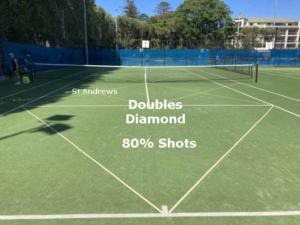It’s disappointing that some coaches are encouraging players to unsettle their opponents in ways that stray from the spirit of fair play. It raises questions about the kind of values these tactics are instilling in young players for the future.
Opponents often have subtle ways to distract you that don’t involve hitting the ball at all. Recognizing these tactics can make a big difference, helping you stay focused, resilient, and in control no matter what comes your way.
Here are some common tactics opponents may use to unsettle you and break your focus:
1. Handling Negative Comments
Some opponents will try to mess with your head by talking to you during the match, making negative comments, or praising your mistakes. They want you to overthink and lose confidence.
2. Slow Play (Stalling)
An opponent may take too long between points, adjusting their equipment, towel breaks, or walking slowly to serve. This slows down your rhythm and makes it hard to stay in your groove.
3. Speeding Up the Game
Opposite to slow play, some players rush between points, serving too quickly or hurrying you into mistakes. If you’re not ready, this tactic can make you feel pressured and lead to rushed, sloppy play.
4. Disputing Calls
Even if they’re not cheating outright, some players will argue every close call, creating tension. They want you to second-guess your own judgment, disrupting your focus on the game.
5. Body Language and Fake Confidence
Opponents might exaggerate their energy or show off overly confident body language—like fist pumps or aggressive looks—trying to intimidate you or make you feel they are unbeatable, even if they’re not.
6. Talking to the Umpire or Asking for Reviews
Constantly questioning the umpire, asking for reviews, or bringing up unnecessary issues can break the flow of the match and throw you off mentally.
7. Changing the Pace of Play
Some opponents will purposely mix up their game—playing slow and defensive, then suddenly hitting aggressive shots. This inconsistent pace can make it hard for you to find your rhythm.
8. Faking Injury or Fatigue
Some players might fake an injury or pretend to be extremely tired, only to suddenly spring back into form. They want you to let your guard down and get caught off-guard when they start playing hard again.
9. Excessive Celebrations
After winning a point, an opponent might celebrate excessively—even on minor points—to make you feel worse about your loss and break your concentration.
10. Disrespecting You or Showing Poor Sportsmanship
Some players will roll their eyes, clap sarcastically, or even avoid shaking hands properly. These small acts of disrespect are designed to irritate you and get under your skin.
11. Deliberate Noise or Distractions
Your opponent might grunt loudly, stomp their feet, or make distracting noises during your serve or rallies to break your concentration.
12. Taking Toilet Timeouts
Sometimes, players will take long medical timeouts to break your momentum. And, talk to the coach in the bathroom! Just remember only you and your opponents can hit the ball — no matter what the coach says.
13. Playing to Your Weaknesses
A smart opponent might relentlessly target your weak spots, like your backhand or net play. This can mentally drain you if you start focusing on your weaknesses rather than adjusting your strategy.
14. Crowd Manipulation
If there’s a crowd, some players may encourage their supporters to make noise, distract you between points or clap your errors. It can be hard to ignore, especially if the crowd is on their side.
15. Faking Agreement in Doubles
In doubles, an opponent might make comments about your partner, pretending to agree with them or saying things to make you doubt your teamwork.
16. Appearing Indifferent
Some players try to act like they don’t care about the outcome, which can make you feel less motivated. They’ll shrug off mistakes or losses as if they don’t matter, trying to make you question why you’re trying so hard.
17. Physical Intimidation
While tennis is non-contact, some players will use their body language or stand very close to you when at the net to intimidate you, making you feel uncomfortable.
18. Feigning Disinterest
An opponent might intentionally play at a lower level during practice or warm-up to make you underestimate them once the match starts. When they switch gears, you may feel caught off-guard.
19. Taking Medical Timeouts
Sometimes, players will take long medical timeouts to break your momentum. While some injuries are real, others can be exaggerated or faked to disrupt your rhythm and focus.
Recognizing these tactics is the first step to staying mentally tough and prepared for anything an opponent throws at you.
Embrace the fact that your opponent seems to believe they can’t beat you through skill alone!
Stick to your game plan, stay composed, and remember that mind games are only effective if you let them get into your head!








